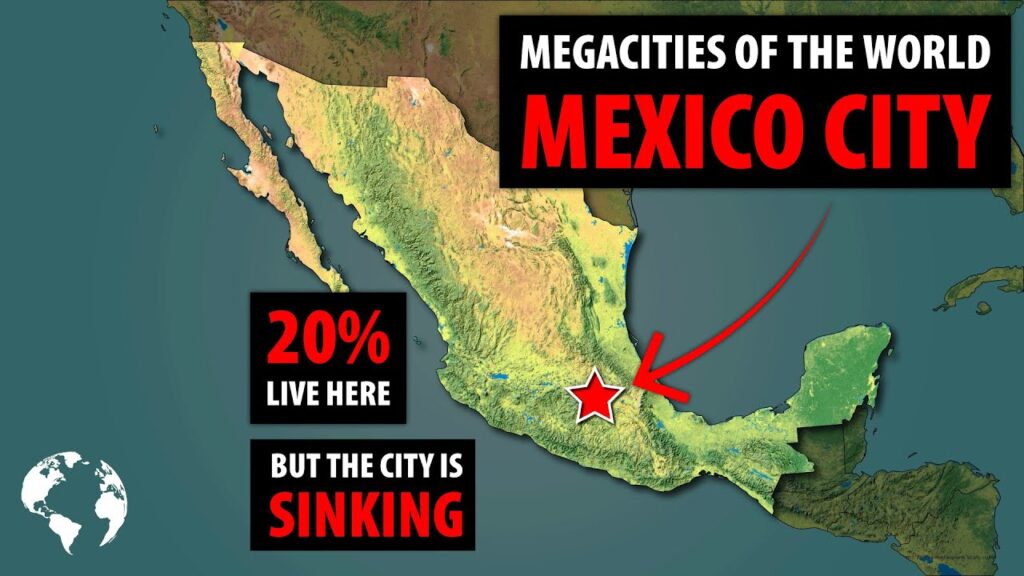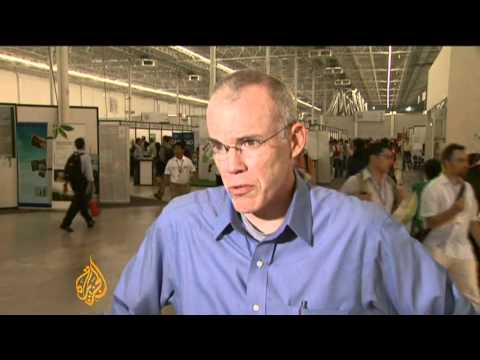Understanding Land Subsidence in Mexico City
Mexico City, the vibrant capital of Mexico, is not only known for its rich cultural history and bustling urban life but also for a pressing environmental issue: land subsidence. This phenomenon, although might not be immediately noticeable to the casual visitor or even to the residents over a short time frame, has significant long-term implications for the city’s infrastructure, water supply, and the safety of its inhabitants.
Land subsidence in Mexico City is primarily caused by the over-extraction of groundwater. The city was originally built on an ancient lake, and as the population has exploded, so has the need for more water. This demand has led to the over-pumping of groundwater, leading to the ground collapsing in on itself as the water that once supported its structure is removed. Another contributing factor is the type of soil present in the area, a soft, clay-rich soil that is particularly susceptible to compression once the water is withdrawn.
The effects of land subsidence in Mexico City are far-reaching. Buildings and streets can crack and become uneven, leading to increased maintenance costs and posing a risk to public safety. The sinking of the city also complicates its drainage and sewage system, making it more difficult to manage rainwater and potentially contributing to flooding. Subsidence isn’t uniform across the city, which means some areas are more affected than others, complicating efforts to address and mitigate the issue on a city-wide scale.
What Causes Land Subsidence in Mexico City?
Mexico City is experiencing significant land subsidence, a phenomenon where the ground sinks due to various factors. One of the primary causes of this subsidence is the excessive extraction of groundwater. Originally built on an ancient lake, Mexico City has relied heavily on groundwater for its water supply. As the water is extracted, the soil compacts and settles, leading to the sinking of the city’s surface. This over-extraction has resulted in uneven land subsidence, with some areas sinking more than others, causing damage to buildings, roads, and infrastructure.
Another contributing factor to the land subsidence in Mexico City is the weight of the urban area itself. The city is home to over 21 million people, according to recent estimates, with extensive buildings, roads, and other infrastructures. The sheer weight of these structures adds pressure to the ground, exacerbating the sinking process, especially in areas where the soil is already weakened by water extraction. This has led to increased strain on the city’s infrastructure, necessitating ongoing repairs and reconstruction efforts.
Geological factors also play a significant role in Mexico City’s land subsidence. The city sits atop a mix of different soil types, including clay, which is particularly susceptible to compaction. The varying resistance of these soil types to weight and water extraction leads to uneven subsidence across the city. Moreover, seismic activity, common in the region, further complicates the situation by causing shifts in the ground that can accelerate the subsidence process. These natural factors, combined with human activities, present a complex challenge in managing and mitigating land subsidence in Mexico City.
The Impact of Groundwater Depletion on Infrastructure
Groundwater depletion in Mexico has become a significant concern over recent years, especially considering the country’s dependence on this crucial resource for various needs, including irrigation, drinking water, and industrial use. As the groundwater levels continue to drop, the impact on infrastructure becomes increasingly apparent and worrisome. This situation has led to noticeable effects on buildings, roads, and even entire communities, underscoring the urgency of addressing this issue.
One of the most visible consequences of groundwater depletion on infrastructure is the phenomenon of land subsidence. As the water levels beneath the ground decrease, the soil begins to compact and settle, leading to the gradual sinking of the land surface above. This process can cause severe damage to buildings and roads, creating structural weaknesses that can lead to cracks, fractures, and, in extreme cases, collapse. In urban areas, the effect on infrastructure is particularly acute, with Mexico City being a notable example where subsidence has damaged homes, historic buildings, and the city’s intricate water pipeline system.
Furthermore, the depletion of groundwater resources also exacerbates the challenges faced by agricultural infrastructure. Irrigation systems, crucial for the agricultural sector, become less effective as the water levels in wells drop, forcing farmers to invest in deeper wells or alternative water sources. This situation not only increases the operational costs for farmers but also puts additional stress on the already scarce groundwater supplies, creating a cycle that further diminishes the available water resources.
The impact on sewage and drainage systems also cannot be overlooked. As the ground settles unevenly due to subsidence, these systems can become misaligned or even damaged, leading to inefficiencies and increased risks of pollution. The alteration of the natural flow of water due to the changing ground levels can further strain these systems, complicating the management of stormwater and wastewater in affected areas. This, in turn, poses significant public health and environmental risks, highlighting the interconnected nature of groundwater depletion and urban infrastructure challenges.
Historical Context of Mexico City’s Geographical Challenges
Mexico City, one of the world’s largest metropolitan areas, is not only the political and cultural hub of Mexico but also a place faced with significant geographical challenges. These challenges are steeped in a rich historical context that spans several centuries, offering a glimpse into the complex relationship between the city’s development and its natural environment.
The city is built on the remnants of Lake Texcoco, an area that provided the Aztecs with a strategic advantage for defense and water supply, leading to the establishment of Tenochtitlán in 1325. However, this choice of location has also presented enduring challenges. The Spanish conquest in the 16th century marked a turning point, as the colonizers embarked on an ambitious project to drain the lake to prevent flooding. This endeavor set a precedent for the city’s continuous struggle with water – a battle against both its scarcity and its abundance.
Earthquakes are another significant geographical challenge that Mexico City has faced throughout history. The city’s location on a former lakebed amplifies seismic waves, making it especially susceptible to earthquake damage. The devastating earthquakes of 1985 and more recently in 2017 are stark reminders of the city’s vulnerability. These events have shaped building codes and emergency preparedness measures, reflecting an ongoing adaptation to this geographical challenge.
Air pollution has emerged as a modern challenge for Mexico City, exacerbated by its geography. Surrounded by mountains, the city is situated in a basin that traps pollutants, leading to poor air quality that affects millions. Historical practices, such as the extensive use of automobiles and industrial growth, have contributed to this issue. Yet, it also reveals the city’s resilience and capacity for innovation as it implements green infrastructure and policies to combat this problem.
Lastly, the subsidence of land is a unique geographical challenge rooted in the city’s history of water management. The drainage of water from the soil to prevent flooding and to supply the growing population has caused the city to sink, in some areas at a rate of up to 12 inches per year. This issue underscores the complex interplay between the city’s historical attempts to overcome its geographical challenges and the unintended consequences of those efforts.
These geographical challenges of Mexico City illustrate how the city’s history is intrinsically linked to its natural environment. Through centuries of adaptation and innovation, Mexico City continues to confront and navigate the complexities of its unique location.
Adapting to Change: Solutions and Strategies
In the ever-evolving world of travel, adapting to change is not just about staying ahead; it’s about embracing new challenges with innovative solutions. As the landscape of travel in Mexico undergoes shifts – influenced by environmental conditions, cultural trends, and technological advancements – travelers and providers alike must adopt flexible strategies to navigate these changes successfully. This evolution presents an exciting opportunity to redefine adventure travel in Mexico, ensuring it remains a thrilling and sustainable pursuit.
One key strategy in adapting to these changes involves the integration of technology. From apps that provide real-time weather updates to platforms offering virtual tours of remote locations, technology serves as a crucial tool in enhancing the travel experience while ensuring safety and minimizing environmental impact. Such innovations allow adventurers to explore Mexico’s rich landscapes and cultures with greater awareness and preparedness, making each journey not just a trip but an informed exploration.
Sustainability practices are also at the forefront of adapting travel adventures in Mexico. As the importance of preserving natural resources and supporting local communities becomes increasingly recognized, adventure travel needs to align with eco-friendly and socially responsible principles. This means opting for tours that emphasize conservation efforts, choosing accommodations that strive for minimal environmental footprints, and engaging in activities that respect cultural heritage and promote economic benefits for local populations.
Finally, fostering a mindset of resilience and openness among travelers is crucial. This involves setting realistic expectations, being prepared for unexpected shifts in plans, and remaining open to new experiences and learning opportunities. By viewing changes not as obstacles but as gateways to undiscovered adventures, travelers can fully embrace the dynamic nature of adventure travel in Mexico, enriching their journeys with flexibility, respect, and a deep connection to the vibrant tapestry of landscapes and cultures they explore.
Exploring the Future of Mexico City
Mexico City, a vibrant metropolis brimming with history and culture, is continuously evolving. As we look to the future, this city is poised to redefine itself, embracing innovation and sustainability while cherishing its rich heritage. Delving into the future of Mexico City offers a glimpse into a destination that is constantly reinventing itself to become an even more enticing place for adventurers and culture enthusiasts.
The city’s urban landscape is undergoing transformative changes aimed at sustainability and resilience. Efforts to expand green spaces and develop eco-friendly public transportation options are at the forefront. These initiatives are designed to enhance the quality of life for residents and visitors alike, making the metropolis a model for sustainable urban living. Imagine exploring vast parks and gardens that dot the cityscape, providing lush oases amidst the urban expanse—these spaces not only offer refuge and relaxation but also play a crucial role in Mexico City’s environmental strategy.
Cultural preservation paired with modernization is a key theme for the future of Mexico City. The city’s authorities and communities are dedicated to safeguarding iconic landmarks and traditions, while integrating contemporary architecture and technologies. This blend of the old and the new ensures that the city remains a dynamic tapestry of Mexican heritage, offering immersive experiences that link the past, present, and future. From cutting-edge museums showcasing digital art to historical sites equipped with augmented reality guides, visitors will delve into a world where history meets innovation.
Investments in technology and infrastructure are set to enhance Mexico City’s appeal as a top travel destination. With plans to improve connectivity through the digitalization of services and the introduction of smart systems for navigation and accommodation, the city aims to offer seamless experiences for travelers. This digital transformation will not only make exploring the city more accessible but also open new avenues for discovering its hidden gems and stories.


